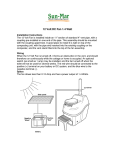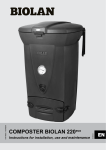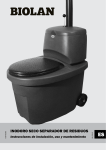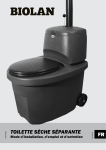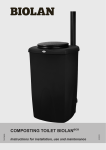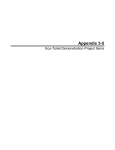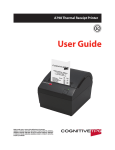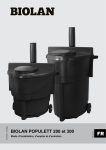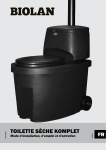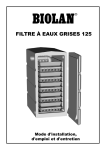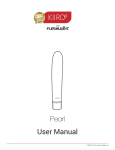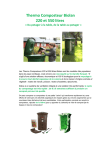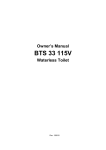Download SEPARATING DRY TOILET
Transcript
Instructions for installation, use and maintenance 01/2012 70570300 SEPARATING DRY TOILET EN 1 2 SEPARATING DRY TOILET Instructions for installation, use and maintenance The Biolan Separating Dry Toilet is a toilet unit to be placed either indoors on the floor surface or in a separate toilet building. The Separating Dry Toilet operates by separating solid and liquid waste matter in the seat part of the unit. The toilet requires neither water nor electricity supply. Contents Component list EN-2 1. Planning and installation EN-3 1.1Placing the Separating Dry Toilet in the toilet space EN-3 1.2 Installing the ventilation pipe EN-3 1.3 Conducting the liquid away after separation EN-3 2.Use and maintenance of the Biolan Separating Dry Toilet EN-4 2.1Before use EN-4 2.2 Using bulking material EN-4 2.3 Year-round use of the toilet EN-4 2.4 Emptying the inner receptacle EN-4 2.5 Emptying the liquid tank EN-5 2.6 Cleaning the Separating Dry Toilet EN-5 3. Problems that may occur EN-5 3.1 Odours and moisture EN-5 3.2 Insects 4. Composting the toilet waste EN-5 EN-5 5. Utilisation of liquid EN-5 6. Disposal of the product EN-5 Biolan accessories EN-6 About the guarantee EN-6 Dimensions EN length 78 cm width 59.4 cm sitting height 53 cm height 85 cm height to the batcher's knob 98.5 cm weight about 16 kg volume of the bulking material container 30 litres size of the inner receptacle 28 litres diameter of the ventilation pipe 75 mm length of the ventilation pipe 750 mm length of the ventilation pipe 600 mm diameter of the liquid removal pipe 32 mm EN-1 Component list EN Component Part name Part No. Material 1 Toilet tank, blue or 17703010 PE 1 Toilet tank, white 17742010 PE 2 Lid, blue or 17703020 PE 2 Lid, white 17742020 PE 9 3 Bulking material container, blue or 17703030 PE 3 Bulking material container, white 17742030 PE 7 4 Cover for the container, blue or 17703040 PE 4 Cover for the container, white 17742040 PE 5 Inner receptacle 18703050 PE 13 6 Cover for inner receptacle 18703060 PE * Batcher assembled 18703900 10 7 Batcher spring Steel 8 Batcher rod Steel 9 Rod washer Steel 10 Rod nut Steel 11 Batcher knob PE 12 Attachment screw for batcher, 3 pcs. Steel 13 Batcher frame PE 14 Batcher plug PE 15 Batcher sheet PE 16 Drain pipe, black or 28578001 PE 16 Drain pipe, white 28578000 PE 17 Liquid funnel 18703180 PE 18 Guide plate 18703280 PE 19 Flexible ventilation pipe, black or 19704020 PVC + steel 19 Flexible ventilation pipe, white 19704025 PE 20 Ventilation pipe 750 mm 28704030 PE 20 Ventilation pipe 750 mm white, without 28704035 joint sleeve PE 21 Ventilation pipe 600 mm, black or 28704040 PE 21 Ventilation pipe 600 mm, white 28704045 PE 22 Pipe bracket, black or 18704050 PE 22 Pipe bracket, white 18704055 PE 23 Wheel 18704060 PE 24 Lock ring 20070003 Steel 25 Rod 21704190 Steel 26 Pehvakka (in Finland) 70578500 PPE 26 White seat lid (abroad) 18700001 PE 27 Ventilation pipe cap 18710250 PE In addition to the components illustrated in the components picture, the package includes: 27703170 Paper User manual in 10 languages (export prod- 27703175 ucts only) User manual Finnish/Swedish Paper The white toilet unit further includes: Joint sleeve for the ventilation pipe, white 28575030 The ready-assembled batcher includes components: 7.8, 9, 10, 11, 12, 13, 14 and 15 EN-2 PE 11 27 8 4 20 14 12 3 15 26 20 2 18 17 16 22 6 19 5 21 25 1 23 24 1. Planning and installation When selecting a location for, and then installing, the Biolan Separating Dry Toilet, make sure to allow sufficient space for its use and maintenance, and route the ventilation pipe straight up through the roof above the ridge. Collect the liquid in a closed tank for later use, treat it together with other wastewater from the property, or take it to the wastewater treatment plant. When dimensioning the liquid tank and deciding where to locate it, you need to take into account that the daily amount of liquid from the separating toilet is 1-1,5 litres per user. The method for post-treating the solid waste should also be carefully planned, to enable easier servicing of the unit. Installation example The picture is indicative only Technical specifications -------- length 78 cm, width 59.4 cm sitting height 53 cm height 85 cm, 98.5 cm to the batcher's knob weight about 16 kg inner receptacle 28 l, 2 pcs. external diameter of the ventilation pipe 75 mm external diameter of the liquid removal pipe 32 mm 1.1 Placing the Separating Dry Toilet in the toilet space Install the Separating Dry Toilet at a level position on the floor. When deciding where to locate the unit, take into account the space required for its ventilation and liquid removal arrangements, and for its maintenance. 1.2 Installing the ventilation pipe Route the ventilation pipe from the toilet unit straight up over the roof ridge. Any bends in the pipe will impede natural ventilation, causing odour problems. Join up the ventilation pipe as shown in the detail drawing (page 2), and seal the pipe using a sealant suitable for the roofing material. As required, extend the ventilation pipe with a Ø 75-mm sewer pipe, or with the pipe parts that are sold as spare parts for the toilet. In complicated installations, or if installing the toilet within living quarters, it is recommended that the ventilation be ensured using a separate Biolan Exhaust Ventilator or Biolan Wind Fan. You can obtain the Exhaust Ventilator either as an option, or retro-fit it if it proves necessary (see Accessories on page EN-6). The flexible ventilation pipe (part 19) is easiest to install when warm, using a screwdriver as a stretching aid. As necessary, the surfaces can be made slippery using, for example, dishwashing detergent. EN 1.3 Conducting the liquid away after separation Route the liquid after separation from the toilet unit into either the liquid tank or the sewer system. During installation, provide sufficient gradient to enable the liquid to flow without obstruction all the way to the drain. Depending on the installation location, accomplish the lead-through either as a sewer or as a pipe leading through the wall or the floor. The diameter of the toilet unit liquid hose is 32 mm. Sewer pipe parts or a hose 32 mm in diameter are suitable for conducting the liquid away. We recommend using a coupling sleeve at the pipe or hose joint. The toilet unit has no drain trap. If the liquid is routed into a tank, the hose must extend all the way to the bottom, in which case the surface of the liquid in the tank makes a drain trap in the hose. Thus the air cannot flow from the liquid tank back to the toilet unit. The tank must be provided with either a pressure relief valve or some other way for the replacement air. If you intend to route the liquid to the sewer system, your plan should explicitly take into account the ventilation of the sewer system and the toilet space. EN-3 2. Use and maintenance of the Biolan Separating Dry Toilet Using and maintaining the Separating Dry Toilet in accordance with these instructions makes for a much more pleasant experience. Separation of the liquid and the solid waste requires that the Separating Dry Toilet always be used in the seated position. When using the unit for the first few times, verify that your own seating distance and habits are suitable for it. Also instruct your guests on how the toilet should be used. The Separating Dry Toilet is intended for composting toilet waste, including toilet paper. But do not put into it anything that could hamper the treatment of the waste, such as: • debris, sanitary towels • chemicals, lime • detergents, washing water • matches, ash, cigarette butts 2.1 Before use Put a layer of Biolan Compost and Toilet Bulking Material a couple of centimetres thick on the bottom of the foremost inner receptacle (part 5). Fill the bulking material container (part 3) with bulking material. 2.2 Using bulking material There is a bulking material batcher in the bulking material container at the rear of the toilet unit. To use the batcher, press the batcher knob (Fig. 1) briskly. The more briskly you press this knob, the farther the bulking material will be thrown. The bulking material does not need to be added every time the toilet is used; adding it only after defecation is sufficient. Applying suitable bulking material is essential for proper operation of the toilet. For bedding we recommend Biolan Compost and Toilet Bulking Material or Biolan Peat (see Accessories on page EN-6). 1. Batcher knob 2.3 Year-round use of the toilet EN The toilet may be used all year round, if installed in a warm space. Thermal insulation of the ventilation and liquid removal systems in cold areas must then, however, be taken into account. Also provide a sufficient gradient to prevent the liquid from freezing in the pipe. Installed in a cold space, the toilet can freeze during winter. The toilet unit is manufactured of frost-proof polyethylene, so freezing does not damage it. A toilet located in a cold space can be used occasionally during winter. Empty the liquid tank before the liquid in it freezes. If the liquid is collected in a canister, empty the canister in the autumn in order to avoid damage caused by freezing of the liquid. If the bulking material in the container is moist, it may freeze during winter. Then the bulking material batcher does not work and you must apply the bulking material manually. 2.4 Emptying the inner receptacle There are two separate inner receptacles inside the tank of the Separating Dry Toilet (Fig. 2). Use only one receptacle at a time. When a receptacle fills up, move it to the back of the unit and put the other receptacle into use. As required, level the surface of the waste, for example, with a stick. The covers for the inner receptacles are intended for use while transporting the receptacles for emptying. Leave the lid ajar for storing. Once both receptacles have filled up, empty the one that filled up first into the compost. Disconnect the ventilation pipe (Part 21) from the lid of the toilet for emptying (Fig. 3). The flexible ventilation pipe will flex at this stage so that you will be able to lift the pipe. Tilt the lid of the toilet unit to the side or lift it off, so that you can lift the receptacles out of the unit. There is no need to wash the inner receptacles when emptying them. When replacing the receptacles, make sure to position the receptacle in use correctly against the separating bowl. Put a layer of Biolan Compost and Toilet Bulking Material or Biolan Peat a couple of centimetres thick onto the bottom of the receptacle. Refer to page EN-5 for instructions for composting the solid waste from the Separating Dry Toilet. 2. Inner receptacles 3. Disconnecting the ventilation pipe. EN-4 2.5 Emptying the liquid tank Empty the liquid tank, if necessary. The emptying intervals are determined by the size of the liquid tank and by how often the toilet is being used. One person produces 1-1,5 litres of liquid daily. Utilise the liquid that is rich in nutrients, in particular nitrogen, as fertiliser in the yard and garden. Although urine is sterile, it is recommended to keep it in storage for about three months before using it in the garden. You can use a small amount of undiluted liquid as a source of nitrogen for the garden compost and for the compost of separated toilet waste. Optionally, you can take the liquid to the wastewater treatment plant. More about the utilisation of urine on page EN-5. 2.6 Cleaning the Separating Dry Toilet Wash and clean the Separating Dry Toilet, as necessary. Any commonly available domestic cleaning agents may be used. You can disassemble the parts of the toilet to enable proper cleaning of the unit. Wash the liquid bowl in the top, the liquid funnel (part 17) and the drain pipe (part 16) with warm water and mild detergent or crystallised sodium at least once a year to remove any precipitate that the urine may have formed. 3. Problems that may occur 3.1 Odours and moisture No odour problems occur in the Separating Dry Toilet provided that it is installed and used in the correct manner. If odour problems occur, check that: • there is no liquid on the bottom of the toilet tank (part 1). If liquid exists, check the removal hose connection for tightness and wash the tank to eliminate the odour. Make sure that the foremost inner receptacle is correctly positioned against the rim of the separating bowl. • make sure that the ventilation pipe leading from the toilet unit to the roof, is straight and extends above the roof ridge. If the ventilation pipe is not straight or does not extend above the roof ridge, you can repair the installation or improve the ventilation by installing a separate Biolan Exhaust Ventilator or a Biolan Wind Fan (see Accessories on page EN-6). • the hose leading to the liquid canister extends to the bottom of the canister. This ensures that the surface of the liquid in the canister forms a drain trap in the hose, preventing air-flow from the canister towards the liquid bowl. • the waste in the inner receptacles is always covered with Biolan Compost and Toilet Bulking Material or Biolan Peat. The micro-organisms in the compost decompose organic matter under aerobic conditions. After the composting has continued for 1–3 years the result will be compost soil. To ensure that the composting is as efficient as possible, provide the waste-decomposing micro-organisms with favourable living conditions. The basic requirements for compost are the presence of oxygen, moisture and nutrients. The micro-organisms in the compost require moist conditions, so the compost must be suitably moist, but not wet. The solid waste from the Separating Dry Toilet is relatively dry and also poor in nitrogen compared with the Dry Toilet where urine and solid matter are placed into the same tank. Therefore, dampen the compost with water, or with separated urine which provides the compost with a good source of nitrogen supplement. To ensure that the compost is sufficiently airy, use coarse bulking material or branch chaff in layers among the waste. Compost that is too tightly packed or too wet is anaerobic and starts to rot and smell. Cover the surface of the compost carefully with bulking material, garden waste or peat after the addition of toilet waste or liquid. Turn the compost at least once during the summer to ensure that all the ingredients of the compost decompose properly. Toilet waste, composted with care, makes excellent soil conditioner for perennial plants, shrubs, trees and a vegetable plot. 5. Utilisation of liquid Separated liquid can be utilised as nitrogen fertiliser or diluted with water, for example, for lawns, ornamental bushes and perennial plants. In the spring, in connection with the initial fertilisation, it can also be used for a vegetable plot but during the growing season it must not be applied to green vegetables. The recommended storage time for urine is about three months before it should be used in the garden. Do not apply urine to plants in the autumn, in order to avoid disturbing the perennials' preparation for winter. A safe dilution ratio for urine is 1:5, which means one litre is diluted with five litres of water. You can also use undiluted urine, but then you must water the area carefully after the application to avoid early blight. Carry out the application when it is cloudy, either early in the morning or late in the evening, when evaporation of nitrogen and the odour-related problems are at a minimum. During the growing season you can apply 1-1,5 l/m² of undiluted urine in your home garden. Please consult your local waste advisor for regulations on composting. Visit www.biolan.fi for more information on composting and the utilisation of urine. 3.2 Insects Insects do not normally exist in the Separating Dry Toilet. But if flies, for example, appear in the toilet unit, empty both receptacles into a compost and then wash them. Do away with any flying insects in the toilet space, using pyrethrin-based spray. Consult your local garden centre to select a suitable product. Also check that: • the waste in the inner receptacles is always covered with Biolan Compost and Toilet Bulking Material. • the ventilation pipe leading from the toilet unit to the roof, goes straight up and extends above the roof ridge. If the ventilation pipe does not go straight up or does not extend above the roof ridge, repair the installation or improve the ventilation by installing a separate Biolan Exhaust Ventilator or a Biolan Wind Fan (see Accessories on page EN-6). 4. Composting the toilet waste Waste emptied from the Separating Dry Toilet always requires composting before it can be utilised. You can compost the toilet waste together with garden waste and domestic bio-waste. While composting, make sure to observe the local regulations on waste handling, and consider sufficient protective distances to neighbours, wells and nearby bodies of water. Organise the composting so that no liquids seep from the compost into the soil. The Biolan Garden Composter or the Biolan Stone Composter (see Accessories on page 8) is well-suited to the purpose. For hygienic reasons, compost the toilet waste for at least a year before applying it to edible plants. Composting for half a year is sufficient before application to ornamental plants. Burying waste in the ground is prohibited. Do not allow liquids that are rich in nutrients to enter the soil, as these cause an excessively concentrated nutrient load. 6. Disposal of the product The raw materials used are presented in the list (see page 4) Dispose of each part as prescribed. Always follow the regional and collecting-point-specific instructions. 02 PE = polyethylene to energy-from-waste process or recycling of plastic PE-HD 05 PP PP = polypropylene to energy-from-waste process or recycling of plastic RST = stainless steel to recycling of metal Paper to recycling of paper EN-5 EN Biolan accessories Biolan Compost and Toilet Bulking Material Biolan Garden Composter Biolan Peat Biolan Stone Composter Biolan Compost and Toilet Bulking Material is a blend made of pure, dried and ground conifer bark and peat for composting and dry toilets. Applying it regularly to the compost keeps the compost mass airy and ensures the composting is efficient and odourless. Package size: a bag of 40 litres, a bag of 85 litres Product number: 40 l 70562100, 85 l 70562500 Biolan Peat is clean, white non-fertilised or limed sphagnum peat. It is naturally sour. Biolan Peat is suitable for, for example, storing root crop, use as soil conditioner, and use in an evaporating pan for seep liquid. Package size: a bag of 70 litres Product number: 55544200 Biolan Biowaste Bag 40 A biodegradable bag to be placed in the inner receptacle of the toilet, which can be composted. Capacity about 40 litres Roll of 30 bags Product number: 707722001 The Biolan Garden Composter is intended for the composting of domestic, garden and toilet waste in a detached house or a holiday home. Its large, hinged cover makes the filling of the composter easier. The hermetic structure and adjustable air exchange prevent the compost mass from drying, and reduce the need for maintenance. Product number: green 70572000, grey 70576700 The Biolan Stone Composter is intended for the composting of domestic and garden waste in a detached house or holiday home. Thanks to its large size, it is wellsuited to the composting of garden waste and toilet waste from a summer cottage. Biolan Stone Composter having the colour of natural stone merges well with its surroundings, and is well-suited even to small yards. Product number: red granite 70573100, grey granite 70573200 Biolan Pehvakka Biolan Pehvakka is a hinged thermal seat, which is hygienic and durable. The flexible foam material neither cracks in use nor absorbs moisture. Both the lid and the seat ring can be lifted up, which makes thorough cleaning of the seat easier. It can be cleaned using any common domestic cleaning agents. The seat can be fitted in toilets where the distance between the hinge pins is either 16 cm or 18 cm. Product number: 70578500 EN Biolan Wind Fan The Biolan Wind Fan is an efficient exhaust fan that is powered by the wind. It is ideal for improving the ventilation in warehouses, dry toilets, bathrooms, small scale water treatment plants etc, and locations that need good ventilation. The Wind Fan is made of aluminium, and thanks to its very mobile bearing, even a slight breeze can improve ventilation significantly. Product number: 70572500 Biolan Exhaust Ventilator The Exhaust Ventilator with electric drive is designed to improve the ventilation of the dry toilet. The connectors of the Exhaust Ventilator fit directly to a pipe 75 mm in diameter. The ventilator only requires electric power of about 10 W. The ventilator operates with a voltage of 12 V and its rotational speed can be adjusted using the transformer included in the package. Product number: black 70575410, white 705420 About the guarantee The Biolan Separating Dry Toilet is guaranteed for one year. 1. The guarantee is valid from the date of purchase and covers possible defects in material and workmanship. The guarantee does not cover any indirect damage. 2. Biolan Oy retains the right to decide about repairing or replacing damaged parts at its discretion. 3. Any damage resulting from careless or forcible handling of the device – from failure to observe the operating instructions, or from normal wear – will not be covered by this guarantee. For matters related to the guarantee, please consult Biolan Oy directly. Biolan Oy P.O. Box 2, FI-27501 KAUTTUA Tel. +358 2 5491 600 Fax +358 2 5491 660 www.biolan.fi EN-6 19 20












